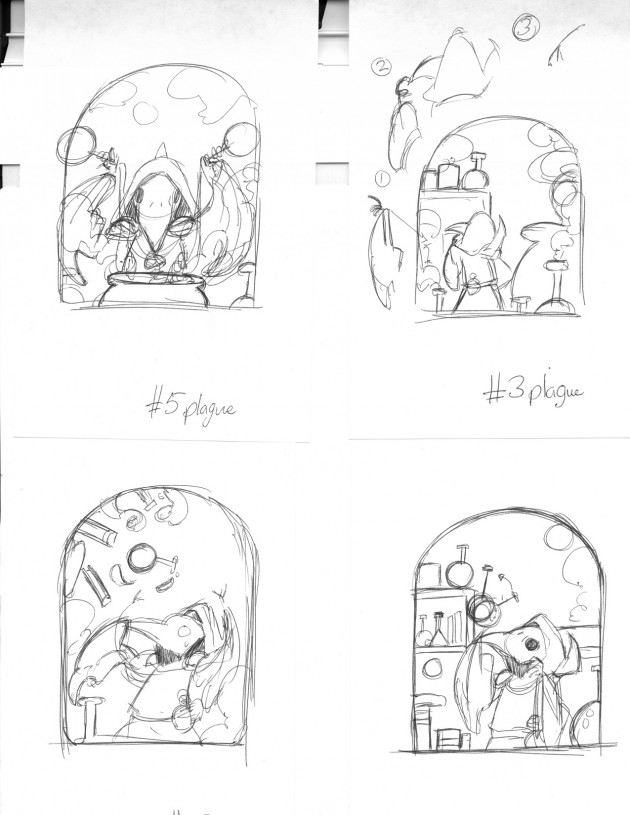Gather around, fellow scientists! Let’s talk about Plague of Shadows, the free update to Shovel Knight where you play as Plague Knight on his own adventure! Making games can be a winding road and we wanted to talk about where our travels have taken us while we put together the latest campaign. If you haven’t yet read about the mobility changes that went into Plague Knight, be sure to check out our previous articles.

A Brand New Brew!
Even in the platformer genre, games are more than just mobility! Beyond Shovel Knight’s jumping and digging is a game about searching for treasure, finding secrets, obtaining relics, and visiting new locations! Surely Plague Knight’s adventure would start by sharing common elements too!
We continued brainstorming what would change in a game centered on the daily life of an alchemist. An idea that bubbled up early was reagents and crafting– new items that could be collected and combined to create a bigger, better arsenal of bombs and potions. If you checked out our screenshots and demo footage from earlier versions, you can see colorful reagent icons dotting the top of the HUD. The working idea was as follows: when defeated, all enemies would now drop a variety of reagents instead of gold. From left to right in the HUD, the broad set of categories were:
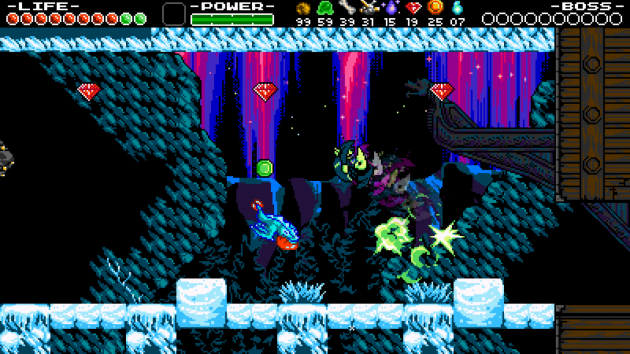
Dirt, Slime, Bone, Metal, Magic, Gem, Coin, and Spirit.
Reagents were then divided out to all enemies based on their theme and difficulty. Skeletons drop bones, mechanical enemies drop metal, and so on. By applying a new layer of “stuff” to the world, it would let the player see existing levels in a new light. Walls of dirt blocks are now ready to be gathered! A lowly skeleton that you might have skipped over previously now might be worth defeating for a critical item. Money would still appear in the world too, but Plague Knight would only think of them in quantity (I have 30 coins and 2 diamonds) rather than value (I have 500 gold).
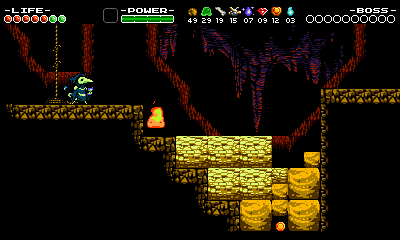
With a collection of reagents in hand you would then be ready to craft new weapons and upgrades. Like enemy rewards, we set out to create new options and behaviors that were somewhat logically tied to the reagent categories. If you were rolling in dirt, so to speak, you could always turn that resource into big explosions! With a lot of diamonds, maybe you could make defensive items. However, when would it be time to craft? Waiting to get back to town to cook up some new equipment would be too long a wait…but having the option to open up a big shopping menu at any time mid-stage would really interrupt the flow of the game. The original Shovel Knight campaign had a long life of iterating on checkpoints, so we continued that proud legacy with the Science Hole.
Down The Science Hole
These pillars of potion making would take the place of all of the torch checkpoints in Shovel Knight’s campaign. Just hop in the top and…
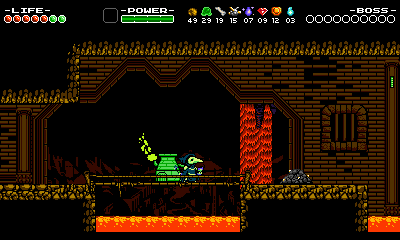
Rough first pass at how the Science Hole(name subject to change) would work. Art, animations...menus...everything, is temp-art!
…start crafting away! Instead of preparing for each level as a whole, now you could use each strut of level to plan what you want to craft and have a little bit of cooling down time to consider your options.
Plague Knight could brew up relics, timed health upgrades, and other limited use items. Doesn’t seem like a enough purchasing options for an entire game, right? That’s because Plague Knight would lose all of his constructed items and upgrades on death! Floating high above waiting to be rescued or discarded forever. This means, on each retry, you would start with no items, equipment, or upgrades! Even your maximum health would be reset! Would you choose to make a risky “corpse run” to restore your status or hastily throw together a few of your favorite items and soldier on?
To gate the player’s progress (and not throw too many options their way at once) you would also need to spend gold to learn and level up individual alchemy recipes. These were the “big purchases” that you could make back at town. Learning a new recipe would let you craft it whenever you were at a Science Hole, and leveling up recipes would either be more powerful, cheaper to use, or cheaper to craft.
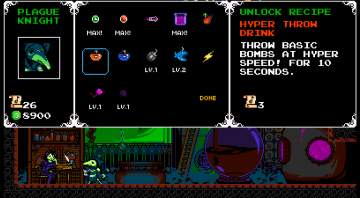
Early recipe shop! You would also spend Song Scrolls to serve as scrap paper when unlocking new recipes!
That was the plan! We readied our reagents, calculated the crafting, and manufactured our menus. Then we did lots of playing! Tuning! Iteration! Values were balanced, art was refined, and new ideas continued to be thrown into the mix. Was this the true form of Plague Knight’s quest!?
A Tepid Reaction
Well, by now we know we’re all aware that, no, it wasn’t quite what we were looking for! We had these features fully functional and running in the game, and continuously discussed them as a team to see how we can best improve it. When it came down to demoing the game at conventions like PAX, we always decided that we should turn these features off until we were really confident in the execution. This was even reminiscent of our early checkpoints in the Shovel Knight campaign: even though we had physical pay-checkpoints in game, we always opted to remove them in showfloor demos because it would only hinder the brief couple of minutes that you’d get to spend with the game demo. The more we iterated the more we realized that hindrance would extend to everyone’s enjoyment of the entire campaign!
Here’s what we discovered:
- Seeing new items pop out of enemies was immediately cool and felt different! But the actual gameplay impact was too much of a drag and just slowed Plague Knight down! We have a fast and fluid main character that can jet around, attack from afar, and have a good time…except that he needs to collect all of this dirt, and that metal, and to stuff his pocket with all of that slime before he moves onto the next screen. Even if you didn’t have any immediate plans for a reagent you’d still think “Hey, maybe I’ll need it later!”.
- No player choice in collection and crafting. A major facet of systems like this is to set your sights on something and see it come together. In a linear stage based game, there really isn’t much say by the player in what items they will come across. You might return from The Lichyard with more bones or Clockwork Tower with spare metal, but you were going to swing by those places anyway! At its contextual best, it would encourage replaying previously cleared stages, which is often not an exciting proposition. At its worst, it would lock you out of using your favorite items.
- Stuff overload! There were a lot of new things to pickup, but not a whole lot of uses for them. Over time we removed and condensed some of the different reagent types and items to a smaller list, but there were still too many and not enough time in a single playthrough to feel like they had value.
- Harsh death! Losing everything when you died sounded cool to a bunch of people who know Shovel Knight from back to front, but the majority of players don’t like losing everything.

Go on, Plague Knight! Recollect all of your precious things! Or just turn off the game, I guess.
Back To The Lab!
While these systems didn’t take flight, we were able find the parts that we did like and create the systems you see in Plague of Shadows today!
Cipher Coins
Collecting a new kind of pickup was fun and seeing a new item made it feel like you were doing more than running a new character through Shovel Knight’s world. Rather than a multitide of concrete reagents we abstracted the collectable out to a single green spinning coin.
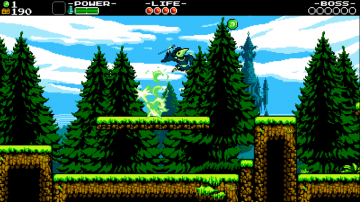
One of the first Cipher Coins a new Plague Knight player will find. It provides a nice, risk-free place to become familiar with Bomb Bursts and multiple jumps!
Plague Knight had a unique ability set that allows him to reach a lot of places that Shovel Knight can’t. These coins were placed methodically in level design to teach, reinforce, and remind the player to use different types of jumps throughout the game, as well as create new challenging paths on an existing stage. Plague Knight still collects and loses gold, but we wanted these coins to feel more important. That’s why we made them permanent collectibles that could never be lost.
These coins were tentatively called Science Coins, Plague Coins, and Green Coins. We ultimately decided on Cipher Coins for the symbols used by alchemists to obscure and share information! Other than a few side events, these coins can be used exclusively for unlocking new tiers of research back at the player’s HQ.
Bomb Part Customization
We still liked the idea of concocting new attacks! We took focus away from limited resources, and costs, and instead moved it to the best part: customization and choice. We broke down all of Plague Knight’s bombs into new ideas for different components based on three properties: Casing, Powder, and Fuse.
The player can change each slot to obtain the type of bomb they wanted to! Whether they just upgraded their bomb to a favorite set or if they swapped it out for approaching a new situation, this provided a fun level of experimentation.
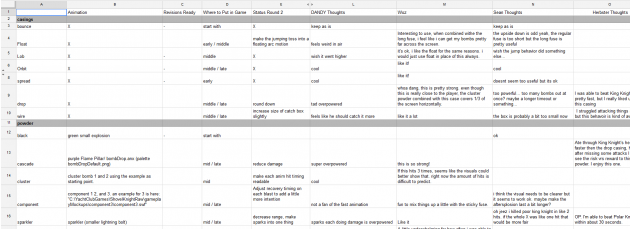
We went through multiple rounds of internal playtesting to make sure each bomb combination made sense, wasn't too powerful, and was at least useful in some way! (Click the image for a larger version!)
Health Tonics
To keep in the spirit of limited resource, item loss, and preparation, Plague Knight can boost up his health by drinking health tonics. The effects of these potions would last until a death and these could be used at anytime, whether reactive at low on health or was preparing up for a big battle. Limited use items can be tricky to introduce, since your first instinct when getting an item like this is to never use it unless you really, really had to. For most players, this means never using them! To encourage routine quaffing we distributed Health Tonics often within levels and only gave the player a small max quantity that they could hold onto at once. That way, at the very least, you would drink a tonic whenever you find yourself at the limit so that any tonics you couldn’t carry wouldn’t go to waste!
And The Rest…
With these elements decided, we were able to continue developing other parts of the game’s design to better suit the character and playstyle. All of that iteration is what ultimately brought us to the campaign you can see and play today! Right now even! As we continue on to the next big Boss Knight Campaign, we’re beginning to think about what new playstyles we can focus on. Maybe Specter Knight will be more combat focused? Maybe King Knight can be more strategic? What would you like to see in the next campaign? Now that you’ve had some time to play, how did you like Plague of Shadows? Let us know!
Want to read more Shovel Knight Design articles? Click here!
Want to learn more about Plague of Shadows? Well then, click here!

